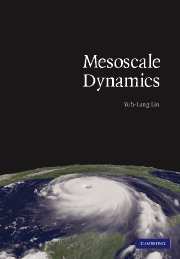Book contents
- Frontmatter
- Contents
- Preface
- 1 Overview
- 2 Governing equations for mesoscale motions
- 3 Basic wave dynamics
- 4 Mesoscale wave generation and maintenance
- 5 Orographically forced flows
- 6 Thermally forced flows
- 7 Mesoscale instabilities
- 8 Isolated convective storms
- 9 Mesoscale convective systems
- 10 Dynamics of fronts and jet streaks
- 11 Dynamics of orographic precipitation
- 12 Basic numerical methods
- 13 Numerical modeling of geophysical fluid systems
- 14 Parameterizations of physical processes
- Appendices
- Index
- References
7 - Mesoscale instabilities
Published online by Cambridge University Press: 15 December 2009
- Frontmatter
- Contents
- Preface
- 1 Overview
- 2 Governing equations for mesoscale motions
- 3 Basic wave dynamics
- 4 Mesoscale wave generation and maintenance
- 5 Orographically forced flows
- 6 Thermally forced flows
- 7 Mesoscale instabilities
- 8 Isolated convective storms
- 9 Mesoscale convective systems
- 10 Dynamics of fronts and jet streaks
- 11 Dynamics of orographic precipitation
- 12 Basic numerical methods
- 13 Numerical modeling of geophysical fluid systems
- 14 Parameterizations of physical processes
- Appendices
- Index
- References
Summary
It is well documented that instabilities play an important role in triggering mesoscale circulations, such as squall lines, mesoscale rainbands, mesoscale convective complexes, frontogenesis, mesoscale cyclogenesis, clear air turbulence, billow clouds and orographic precipitating systems. For example, Fig. 7.1 shows mesoscale cellular convection observed over the Atlantic Ocean off the southeast coast of the United States on February 19, 2002. This type of cloud is an atmospheric manifestation of Rayleigh–Bénard convection, which includes both unstable updrafts and downdrafts and turbulent eddies triggered by the thermal instability between two horizontal plates heated from below, in the atmosphere. Mesoscale cellular convection normally forms as cold air passes over warmer ocean waters, as seen in the wake of a cold front over a warm ocean current during the winter. Hexagonal open cells are produced in the cloud-topped boundary layer and convective clouds exist at the vertices of the hexagonal cells. In these cells, air goes up on the rim and descends in the center where the skies are clear. On the other hand, the circulation associated with a closed cell is opposite to that of an open cell. Normally, moist convection in the atmosphere is associated with localized heat source, and thus behaves quite differently from the mesoscale cellular convection shown in Fig. 7.1. Localized moist convection is characterized by: (1) strong, compact, turbulent, unstable, upward motion, (2) weak, compensated, laminar, stable, downward motion over a wide area of the surroundings, and (3) inertia-gravity waves generated outside and which propagate away from the convective region (Emanuel and Raymond 1984).
- Type
- Chapter
- Information
- Mesoscale Dynamics , pp. 229 - 271Publisher: Cambridge University PressPrint publication year: 2007



